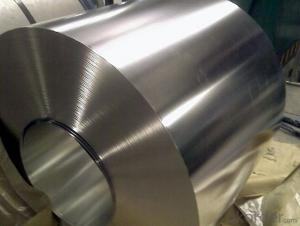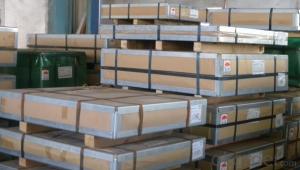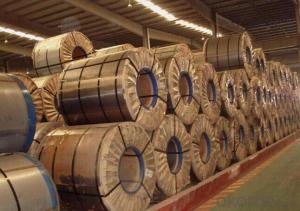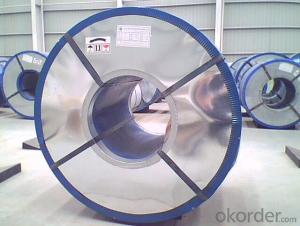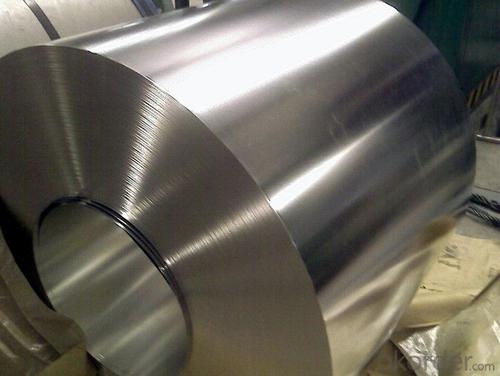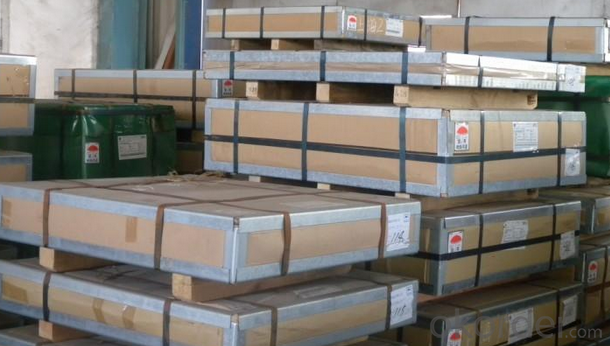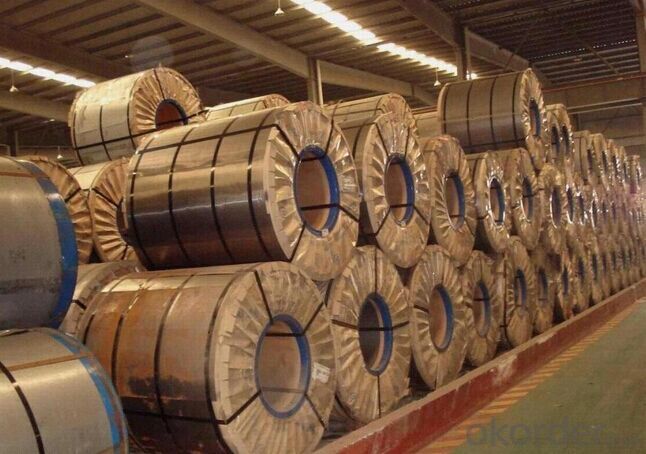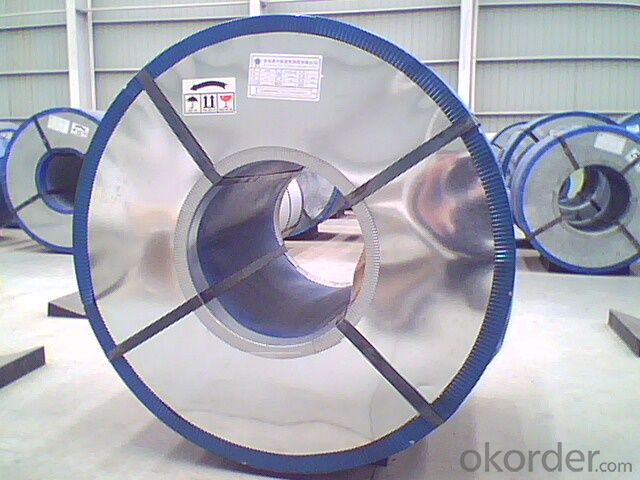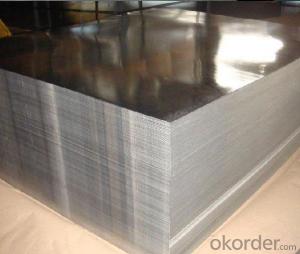Tinplate in Sheets for Cans Packing in good price
- Loading Port:
- Tianjin
- Payment Terms:
- TT OR LC
- Min Order Qty:
- 25 m.t
- Supply Capability:
- 7000 m.t/month
OKorder Service Pledge
OKorder Financial Service
You Might Also Like
1.Structure of Electrolytic Tin Plate Coils and Sheets for Foods Metal Packaging Description
Electrolytic Tin Plate Coils and Sheets for Foods Metal Packaging, is one thin steel sheet with a coating of tin applied by electrolytic deposition. Tinplate made by this process is essentially a sandwich in which the central core is strip steel. This core is cleaned in a pickling solution and then fed through tanks containing electrolyte, where tin is deposited on both sides. As the strip passes between high-frequency electric induction coils, it is heated so that the tin coating melts and flows to form a lustrous coat.
2.Main Features of the Electrolytic Tin Plate Coils and Sheets for Foods Metal Packaging
Appearance – Electrolytic Tin Plate is characterized by its beautiful metallic luster. Products with various kinds of surface roughness are produced by selecting the surface finish of the substrate steel sheet.
Paintability and printability – Electrolytic Tin Plates have excellent paintability and printability. Printing is beautifully finished using various lacquers and inks.
Formability and strength – Electrolytic Tin Plates have got very good formability and strength. By selecting a proper temper grade, appropriate formability is obtained for different applications as well as the required strength after forming.
Corrosion resistance – Tinplate has got good corrosion resistance. By selecting a proper coating weight, appropriate corrosion resistance is obtained against container contents. Coated items should meet 24 hour 5 % salt spray requirement.
Solderability and weldability – Electrolytic Tin Plates can be joined both by soldering or welding. These properties of tinplate are used for making various types of cans.
Hygienic – Tin coating provides good and non toxic barrier properties to protect food products from impurities, bacteria, moisture, light and odours.
Safe – Tinplate being low weight and high strength makes food cans easy to ship and transport.
Eco friendly – Tinplate offers 100 % recyclability.
Tin is not good for low temperature applications since it changes structure and loses adhesion when exposed to temperatures below – 40 deg C.
3.Electrolytic Tin Plate Coils and Sheets for Foods Metal Packaging Images
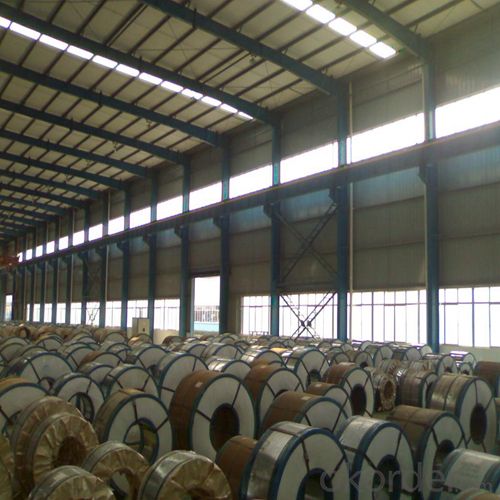
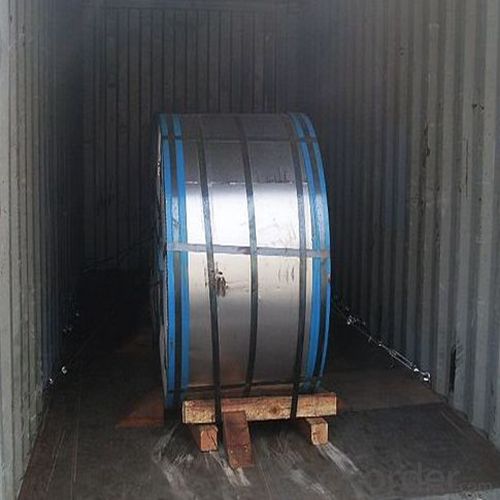
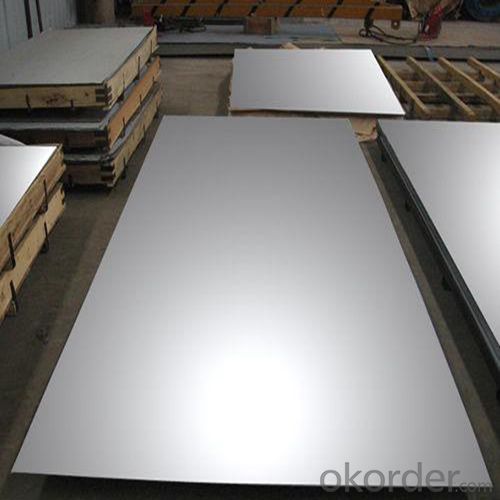
4.Electrolytic Tin Plate Coils and Sheets for Foods Metal Packaging Specification
Standard | ISO 11949 -1995, GB/T2520-2000,JIS G3303,ASTM A623, BS EN 10202
|
Material | MR,SPCC |
Thickness | 0.15mm - 0.50mm |
Width | 600mm -1150mm |
Temper | T1-T5 |
Annealing | BA & CA |
Coil Inner Diameter | 508mm |
Weight | 6-10 tons/coil 1~1.7 tons/sheets bundle |
Passivation | 311 |
Oil | DOS |
Surface | Finish,bright,stone,matte,silver |
5.FAQ of Electrolytic Tin Plate Coils and Sheets for Foods Metal Packaging
-What your tinplate material is used for ?
Tinplate is widely used for the packaging of products. Such as food cans,
beverage cans, pet cans, closures, general line cans and so on.
Printed Tinplate is offered!!
-How to place .an order or contact you ?
Please send us Email. we will give you a quick response in seconds .
- How is your quality ?
All our quality is prime even the secondary quality . We have many years experience
In this field with serious quality control standard . Advanced equipment, We welcome your visit to our factory .
- Q: What are the main applications of tinplate in the gardening industry?
- Tinplate is commonly used in the gardening industry for various applications such as plant pots, seed trays, watering cans, and garden tools. The use of tinplate ensures durability, corrosion resistance, and ease of maintenance, making it an ideal choice for these gardening essentials. Additionally, tinplate can also be utilized for packaging purposes, such as cans for storing fertilizers, pesticides, and other gardening products.
- Q: How does tinplate compare to tin-free steel in terms of properties and applications?
- Tinplate and tin-free steel have distinct properties and applications. Tinplate, which is steel coated with a thin layer of tin, offers excellent corrosion resistance, formability, and solderability. It is commonly used in the food and beverage industry for making cans, containers, and closures due to its ability to preserve the product's quality and prevent contamination. On the other hand, tin-free steel, also known as electrolytic chromium-coated steel, provides superior paint adhesion, scratch resistance, and weldability. It finds applications in manufacturing various products like aerosol cans, automotive parts, and appliances that require durability and aesthetic appeal. Ultimately, the choice between tinplate and tin-free steel depends on the specific requirements of the application at hand.
- Q: How does tinplate compare to plastic packaging?
- Tinplate packaging offers several advantages over plastic packaging. Firstly, tinplate is more durable and can withstand higher temperatures, making it suitable for preserving food and beverages. It also provides better protection against external factors such as sunlight, moisture, and oxygen, thus ensuring the longevity and quality of the contents. Additionally, tinplate is fully recyclable and has a higher recycling rate compared to plastic, making it a more sustainable choice. Lastly, tinplate packaging has a premium appearance that can enhance the product's perceived value and appeal to consumers.
- Q: Can tinplate packaging be used for beverages?
- Yes, tinplate packaging can be used for beverages. Tinplate is a common and suitable material for packaging beverages as it is lightweight, durable, and provides excellent protection against air, light, and moisture. It is commonly used for packaging beverages like canned drinks, juices, and carbonated beverages.
- Q: How does the thickness of tinplate affect its strength?
- The thickness of tinplate directly affects its strength, with a thicker tinplate generally being stronger than a thinner one. Thicker tinplate offers more resistance to bending and deformation, making it more suitable for applications requiring higher strength and durability. However, it is important to find a balance between thickness and other factors such as weight and cost, as excessively thick tinplate may become impractical for certain uses.
- Q: How does tinplate packaging contribute to product visibility?
- Tinplate packaging contributes to product visibility by offering a sleek and shiny surface that enhances the visual appeal of the product. The reflective nature of tinplate allows for better light reflection, making the packaging stand out on store shelves and attracting consumers' attention. Additionally, tinplate can be easily printed and decorated with vibrant designs, logos, and product information, further enhancing product visibility and brand recognition.
- Q: How does tinplate compare to plastic in terms of sustainability?
- Tinplate generally has a better sustainability profile compared to plastic. Tinplate is made from steel, which is a widely recycled material, and it has a high recycling rate. Plastic, on the other hand, is derived from fossil fuels and has a lower recycling rate. Tinplate is also more durable and can be reused multiple times, whereas plastic is often single-use and ends up in landfills or as litter. Additionally, tinplate has a lower carbon footprint and contributes less to environmental pollution compared to plastic. Overall, tinplate is considered a more sustainable packaging option.
- Q: How does the printing process affect the durability of tinplate?
- The printing process can significantly affect the durability of tinplate. It forms a protective layer on the surface of the tinplate, making it more resistant to corrosion and external factors that may cause damage. The printing process also enhances the tinplate's scratch resistance, ensuring that the printed design remains intact for a longer period. Additionally, the printing process can provide an extra layer of insulation, protecting the tinplate from heat and moisture, further increasing its durability.
- Q: How does tinplate perform in terms of durability and longevity?
- Tinplate is known for its exceptional durability and longevity. The tin coating provides excellent corrosion resistance, preventing the metal underneath from rusting or deteriorating. This makes tinplate highly suitable for packaging purposes, as it can protect the contents for an extended period. Additionally, tinplate's sturdy construction ensures it can withstand mechanical stress and maintain its integrity over time, further enhancing its durability and longevity.
- Q: Can tinplate be used for coffee or tea packaging?
- Yes, tinplate can be used for coffee or tea packaging. Tinplate is a popular choice for packaging due to its durability, resistance to moisture and oxygen, and ability to preserve the aroma and flavor of coffee or tea.
Send your message to us
Tinplate in Sheets for Cans Packing in good price
- Loading Port:
- Tianjin
- Payment Terms:
- TT OR LC
- Min Order Qty:
- 25 m.t
- Supply Capability:
- 7000 m.t/month
OKorder Service Pledge
OKorder Financial Service
Similar products
Hot products
Hot Searches
Related keywords
